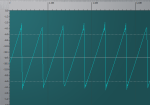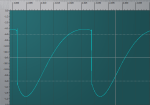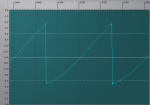Background
The year was 1982. Korg's main competition was Roland, since Yamaha was off developing FM synths (which would be the final blow to analog synth production for the era) and most other (analog) synth manufacturers were either defunct or struggling. Digitally controlled oscillators were the cutting edge technology, promising perfect pitch in any working conditions. Competition centered around how well synth manufacturers could leverage digital technology in the quest for more features and lower costs. Korg introduced the Poly-61, one of the first synths to replace the familiar WYSIWYG programming knobs (found on the PolySix) with a fully digital interface, consisting of two digit parameters and increment/decrement-value buttons (the DW family later marginally improved the interface by replacing the value buttons with a slider). The new dual oscillator architecture (vs. PolySix single oscillator+sub) helped Korg keep up with Roland's new Jupiter line (meanwhile, Roland came out with the Juno line, which was very similar to the PolySix). Korg's next entry was the Poly-800, which paved the way for the DW family (DW-6000, DW-8000, EX-8000) and DSS-1/DSM-1. Six years after Korg's digital revolution began, they unveiled the M1, with a fully digital signal path, ousting the Roland D-50 as the must-have synth of the decade. Korg (along with Roland and Yamaha) would stick to the digital signal path and interface (rompler) formula for decades, to the frustration of many musicians.
Back in the present, I recently wondered if the DW series can completely replace/replicate the Poly-61 (in the quest to ditch redundant gear). Obviously, the Poly-800 family would have difficulty emulating a Poly-61, due to the shared filter and square wave based oscillators. The Poly-800 and DW families share the same parameter numbering, making life easy for a Poly-61 owner to adopt subsequent synths lines. So, how deep do the similarities go?
Modulation Differences
At a glance, the Poly-61 modulation looks weak when compared to the DW family. The Poly-61 takes after the PolySix, regarding sedate modulation options, the only major difference being a dedicated joystick (vs. PWM) LFO. Indeed the LFO capabilities are one common area of all Korg synths from the PolySix through the DW family (exception: PolySix LFO can modulate volume). The humble shared ADSR envelope on the Poly-61 is no match to the flexibility of the dedicated ADBSSR filter and amp envelopes in subsequent synths (DW and Poly-800 families, DSS-1, DSM-1). The Poly-61 is also missing the filter envelope polarity of it's siblings (PolySix through DSS-1/DSM-1). The Poly-61 does have an arpeggiator (like the PolySix and DW-8000/EX-8000) and chord memory (like the PolySix), but no portamento or unison (unlike subsequent generations). However, taking a look at the modulation flexibility of each only scratches the surface of the comparison.
Signal Path Differences



While being one of the few Korg synths of the era to lack a noise generator and chorus (or delay), the Poly-61 is the last Korg of the era to feature PWM, since PWM is not implemented in memory based oscillators (DW family, DSS-1, DSM-1, romplers). As is typical, the saw waveform only looks like a saw from the middle range up (C3 -C6, see pic), being much more rounded at low frequencies. Memory based oscillators tend to roll off (look like a sine wave) at higher frequencies, usually due to the post-DAC reconstruction filter (to avoid aliasing).
However, just when the Poly-61 looks like a hopeless relic destined to become a door stop, something amazing happens when it is played. While we try to avoid the subjective, in this case, that is all that is left to plead the Poly-61 case. The opamp based filters are very warm and thick, sounding nothing like the integrated 2069 filters in the DSS-1, DSM1, Poly-800 and DW families. This alone makes it very difficult to create much more than an approximation of the Poly-61 sound on the DW series, which tend to have a sharper sound.
Conclusion
So, while the Poly-61 is very limited, compared to the DW series, the sound can not be duplicated. Furthermore, the DW series crispness actually compliments the Poly-61 warmth nicely, allowing them to coexist in a mix.